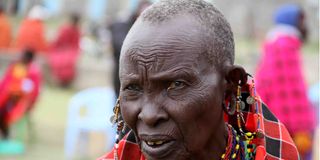Survey reveals leading causes of blindness in older people

A resident of Narok West Sub-County who has been afflicted by visual impairment.
What you need to know:
- According to CBM Kenya, about 7.5 million Kenyans need eye care services due to cataracts, diabetic eye complications, refractive errors, trachoma, allergy and reading difficulties.
- However, more than five million of these do not have access to eye care services due to a shortage of eye specialists and necessary equipment.
Cataracts and diabetes are the top causes of blindness among the elderly population in the country, shows a new survey.
According to preliminary findings of the ongoing survey dubbed ‘Rapid Assessment of Avoidable Blindness’ that is aimed at finding out the causes of blindness, eye infections have reduced across the country over time.
The research, which is also aimed at establishing the magnitude of blindness and visual impairment among Kenyans over the age of 50, was conducted in 16 counties including Meru, Vihiga, Bomet, Nakuru, Kajiado, Embu, Murang’a, Kiambu and Tharaka Nithi.
The research under Christian Blind Mission (CBM) Vision Impact Project (VIP) will also be conducted in Kakamega, Busia, Mombasa, Kwale, Migori and Turkana.
The VIP initiative is targeting eight million people in the comprehensive eye care programmes.
According to Dr Hillary Rono, an ophthalmologist involved in the research, preliminary findings indicate that blindness prevalence is about 0.3 per cent of the population compared to 1990’s findings that placed the prevalence at 0.5 per cent.
“The last survey published in 1990 showed that the main cause of blindness was cataracts and eye infections. However, our survey has so far shown that blindness has reduced and eye infections are lower. What we have are more cases of diabetes. Cataracts remain a main cause of blindness,” Dr Rono said. He noted that their initial findings indicate that cases of glaucoma, a condition that damages the optic nerve, were also on the rise. “This calls for more research to establish the extent of glaucoma as a cause of blindness. There is a need for investment in early diagnosis because glaucoma is a painless silent vision robber,” he said.
Dr Rono noted that a shortage of ophthalmologists, ophthalmic nurses and clinical officers as well as optometrists is contributing to late diagnosis of blindness-causing conditions.
He added that refractive error remains one of the leading causes of blindness yet with the right prescription of eyeglasses, the condition can be corrected. “Optometrists who recommend the right pair of eyeglasses are very few in the country. There is also a need to address the cost of eyeglasses to increase access across the country,” the Trans Nzoia-based ophthalmologist said.
Counties have been advised to enhance access to surgical treatment in their eye units since cataracts cause 50 per cent of blindness cases in the country.
According to CBM Kenya, about 7.5 million Kenyans need eye care services due to cataracts, diabetic eye complications, refractive errors, trachoma, allergy and reading difficulties.
However, more than five million of these do not have access to eye care services due to a shortage of eye specialists and necessary equipment.
The National Eye Health Strategic Plan 2020-2025 indicates that there are about 145 ophthalmologists, 400 optometrists, and 216 ophthalmic clinical officers in the country. The strategy plan further says there is no accurate data on eye conditions in the country because the indicators of eye health are not coded. This makes it difficult to enter them into the Kenya Health Information System.
The VIP programme intends to use the outcomes of the RAAB, to address the gaps in eye health care in Kenya.





